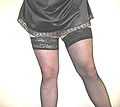Transvestic fetishism
| Cross-dressing |
|---|
| History of cross-dressing |
| Key elements |
| Modern drag culture |
| Sexual aspects |
|
|
Sexual attraction to cross-dressers |
|
| Other aspects |
|
| Passing as male |
| Passing as female |
|
| Organizations |
| Books |
|
Transvestic fetishism is a psychiatric diagnosis applied to those who are thought to have an excessive sexual or erotic interest in cross-dressing; this interest is often expressed in autoerotic behavior. It differs from cross-dressing for entertainment or other purposes that do not involve sexual arousal, and is categorized as a paraphilia in the Diagnostic and Statistical Manual of the American Psychiatric Association.[1] (Sexual arousal in response to donning sex-typical clothing is homeovestism.)
Description
A person who is diagnosed with Gender Identity Disorder should not receive a diagnosis of Tranvestic Fetishism,[2] although sometimes those with this diagnosis do go on to develop gender dysphoria, and then meet the criteria for a diagnosis of Gender Identity Disorder.[2] Most men who have transvestic fetishism do not have a problem with their assigned sex.
Some male transvestic fetishists collect women's clothing, e.g. nightgowns, babydolls, bridal gowns, slips, brassieres, and other types of nightwear, lingerie, stockings, pantyhose, shoes, and boots, items of a distinct feminine look and feel. They may dress in these feminine garments and take photographs of themselves while living out their fantasies. According to the DSM-IV, this fetishism has been described mostly in heterosexual men.
There are two key criteria before a psychiatric diagnosis of "transvestic fetishism" is made:[2]
- Recurrent, intense sexually arousing fantasies, urges, or behaviour, involving cross-dressing.
- This causes clinically significant distress or impairment, whether socially, at work, or elsewhere.
Thus, transvestic fetishism is not diagnosed unless it causes significant problems for the person concerned.
Gallery
-

An example of transvestic fetishism
-

Some men find the sheer fabric of stockings highly erotic
-

Transvestic fetishism involving a half slip and stockings
See also
References
- Sources
- Laws, Richard D.; O'Donohue, William T., eds. (2008). Sexual Deviance: Theory, Assessment, and Treatment (2 ed.). New York: Guilford Press. ISBN 978-1-59385-605-2.
- Notes
- ↑ American Psychiatric Association (2013). Diagnostic and Statistical Manual of Mental Disorders (Fifth ed.). Arlington, VA: American Psychiatric Publishing. pp. 685–705. ISBN 978-0-89042-555-8.
- ↑ 2.0 2.1 2.2 American Psychiatric Association. (2000). Diagnostic and Statistical Manual of Mental Disorders (4th ed., text rev.). Washington, DC: Author.
| ||||||||||||||||||||
| ||||||||||||||||||||||||||||||
| ||||||||||||||||||||||||||